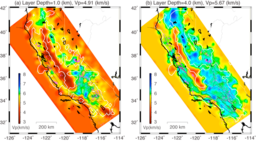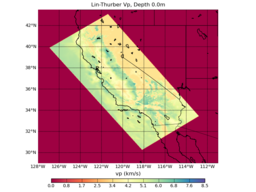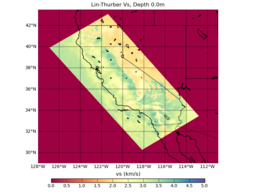Difference between revisions of "Lin Thurber CVM"
| (15 intermediate revisions by 2 users not shown) | |||
| Line 1: | Line 1: | ||
| − | + | = Overview = | |
| − | + | The Lin Thurber et al (2010) CVM is a seismic velocity model of the California crust and uppermost mantle using a regional-scale double-difference tomography algorithm. The details are described in Lin et al. (2010). This model has been incorporated into the [[UCVM API]]. | |
| + | |||
| + | [[Image:MapviewP_statewide.png |256px|thumb|right|Map views of the P-wave velocity model at 1 and 4 km depth slices. Pink dots represent relocated earthquakes. Black lines denote coast line and lakes, gray lines rivers and surface traces of mapped faults. The white contours enclose the areas where the derivative weight sum is greater than 50 (Image Credit: Guoqing Lin]] | ||
| + | |||
| + | |||
| + | = Original Model = | ||
| + | |||
| + | Recently, we determined the seismic velocity model of the California crust and uppermost mantle using a regional-scale double-difference tomography algorithm. Our model is the first 3D seismic velocity model for the entire state of California based on local and regional arrival time data that has ever been developed. It has improved areal coverage compared to the previous northern and southern California models, and extends to greater depth due to the inclusion of substantial data at large epicentral distances. | ||
| + | |||
| + | *[http://www.rsmas.miami.edu/personal/glin/Statewide.html Lin Web Page With Original Model]. | ||
| + | |||
| + | |||
| + | = UCVM Implementation = | ||
| + | |||
| + | |||
| + | == Projection == | ||
| + | |||
| + | The UCVM API implementation of Lin-Thurber uses a geographic bilinear interpolation of the four corners of the model as a projection approximation. The four corners are: | ||
| + | |||
| + | <pre> | ||
| + | proj_xi = -126.9210, -121.4117, -112.8281, -118.1781 | ||
| + | proj_yi = 39.8816, 43.0597, 33.4362, 30.2581 | ||
| + | </pre> | ||
| + | |||
| + | The region is sized 1320km x 600km. The DEM, Vp, and Vs models all use this projection. The actual number of grid points along each dimension is dependant on the resolution of the particular DEM/Vp/Vs model. These are described below. | ||
| + | |||
| + | |||
| + | == Digital Elevation Model == | ||
| + | |||
| + | In order to query this model by depth, a state-wide DEM was constructed. The DEM is a 1320km x 600km grid with spacing of 1.0km. It was compiled by combining the NED 1 arcsec (DEM) and ETOPO2 2' (Bathymetric) datasets. The elevation at a particular lon,lat coordinate is computed by bilinear interpolation of the surrounding four points in the grid. | ||
| + | |||
| + | In UCVM, depth is defined as the offset from the free surface (ground-air interface, ground-water interface), positive down. Negative depths are not supported. | ||
| + | |||
| + | |||
| + | == Material Properties == | ||
| + | |||
| + | The Lin-Thurber implementation provides Vp, Vs, and density values for every point in the defined region. Vp and Vs are sourced directly from the original model files. Density is derived computationally from Vp. | ||
| + | |||
| + | |||
| + | === Vp Values === | ||
| + | |||
| + | The Vp model is a 1320km x 600km x 46km grid with spacing of 10.0km along the x-y plane and variable spacing along the z axis. The z coordinate is measured as km offset from MSL, positive down. The z values contained in the model are: | ||
| + | <pre> | ||
| + | -1.0, 1.0, 4.0, 8.0, 14.0, 20.0, 27.0, 35.0, 45.0 | ||
| + | </pre> | ||
| + | |||
| + | The model is published as a space-delimited text file, available from [http://www.rsmas.miami.edu/personal/glin/Statewide_files/out.vp Vp Model]. The model file format is a table of data values in the following format: | ||
| + | <pre> | ||
| + | FILE FORMAT DESCRIPTION | ||
| + | -117.7230 37.8242 1.00 250.00 0.00 5.0390 109.13 | ||
| + | lon lat dep x y vp DWS (derivative weight sum) | ||
| + | </pre> | ||
| + | |||
| + | The UCVM API reads in this file directly without changes. The Vp at a particular lon,lat coordinate is determined by trilinear interpolation of the surrounding 8 points. | ||
| + | |||
| + | |||
| + | === Vs Values === | ||
| + | |||
| + | The Vs model is a 1320km x 600km grid with spacing of 30.0km along the x-y plane and the same z-axis organization as the Vp model. The model is published as a space-delimited text file, available from [http://www.rsmas.miami.edu/personal/glin/Statewide_files/out.vs Vs Model]. The model file format is the same as Vp model. The UCVM API reads in this file directly without changes. The Vs at a particular lon,lat coordinate is determined by trilinear interpolation of the surrounding 8 points. | ||
| + | |||
| + | |||
| + | === Density Values === | ||
| + | |||
| + | The original model does not provide density values. We adopt the Nafe-Drake scaling relationship to compute density from Vp (Ludwig et al., 1970; Brocher , 2005): | ||
| + | <pre> | ||
| + | rho = 1.6612*Vp - 0.4721*(Vp)^2 + 0.0671*(Vp)^3 - 0.0043*(Vp)^4 + 0.000106*(Vp)^5 | ||
| + | </pre> | ||
| + | |||
| + | |||
| + | = Images = | ||
{| class="wikitable" | border="0" | {| class="wikitable" | border="0" | ||
|- | |- | ||
|- | |- | ||
| − | | [[Image:Lin_Thurber_Vp.png|256px|thumb| | + | | [[Image:Lin_Thurber_Vp.png|256px|thumb|Lin Thurber CVM Vp Map at 0km Depth]] |
| − | | [[Image:Lin_Thurber_Vs.png|256px|thumb| | + | | [[Image:Lin_Thurber_Vs.png|256px|thumb|Lin Thurber CVM Vs Map at 0km Depth]] |
|} | |} | ||
| − | These preliminary maps are based on querying the model at | + | These preliminary maps are based on querying the model at a depth of 0.0m. The low velocities in the Tahoe region are due to interactions of the DEM with the upper two layers of the Vp/Vs models. Here, the high elevations cause material properties to be pulled from the -1.0km model layer which seems to have very low velocities for most of the state. To the west in the central valley, lower elevations cause material properties to be pulled from the 1.0km model layer. |
| − | + | Additional profile and map plots are available at [http://earth.usc.edu/~patrices/ucvm/lin-thurber/index.html Lin-Thurber Plots]. | |
| − | = | + | = References = |
| − | + | #'''Brocher, T. M.''' (2005), Empirical relations between elastic wavespeeds and density in the Earth's crust, Bull. Seis. Soc. Am., 95 (6), 2081-2092. | |
| + | #'''Lin, G., C. H. Thurber, H. Zhang, E. Hauksson, P. Shearer, F. Waldhauser, T. M. Brocher, and J. Hardebeck''' (2010), A California statewide three-dimensional seismic velocity model from both absolute and differential Times, Bull. Seism. Soc. Am., 100, in press. | ||
| + | #'''Ludwig, W. J., J. E. Nafe, and C. L. Drake''' (1970), Seismic refraction, in New Concepts of Sea Floor Evolution, The Sea: Ideas and Observations on Progress in the Study of the Seas, vol. 4, edited by A. E. Maxwell, pp. 53-84, Wiley-Interscience, New York. | ||
| − | *[ | + | == Related Entries == |
| + | *[[UCVM]] | ||
| + | *[[CyberShake]] | ||
| − | + | == See Also == | |
| − | + | *[[Main Page]] | |
| − | + | *[http://www.scec.org SCEC Home] | |
Latest revision as of 17:42, 19 April 2011
Contents
Overview
The Lin Thurber et al (2010) CVM is a seismic velocity model of the California crust and uppermost mantle using a regional-scale double-difference tomography algorithm. The details are described in Lin et al. (2010). This model has been incorporated into the UCVM API.

Original Model
Recently, we determined the seismic velocity model of the California crust and uppermost mantle using a regional-scale double-difference tomography algorithm. Our model is the first 3D seismic velocity model for the entire state of California based on local and regional arrival time data that has ever been developed. It has improved areal coverage compared to the previous northern and southern California models, and extends to greater depth due to the inclusion of substantial data at large epicentral distances.
UCVM Implementation
Projection
The UCVM API implementation of Lin-Thurber uses a geographic bilinear interpolation of the four corners of the model as a projection approximation. The four corners are:
proj_xi = -126.9210, -121.4117, -112.8281, -118.1781 proj_yi = 39.8816, 43.0597, 33.4362, 30.2581
The region is sized 1320km x 600km. The DEM, Vp, and Vs models all use this projection. The actual number of grid points along each dimension is dependant on the resolution of the particular DEM/Vp/Vs model. These are described below.
Digital Elevation Model
In order to query this model by depth, a state-wide DEM was constructed. The DEM is a 1320km x 600km grid with spacing of 1.0km. It was compiled by combining the NED 1 arcsec (DEM) and ETOPO2 2' (Bathymetric) datasets. The elevation at a particular lon,lat coordinate is computed by bilinear interpolation of the surrounding four points in the grid.
In UCVM, depth is defined as the offset from the free surface (ground-air interface, ground-water interface), positive down. Negative depths are not supported.
Material Properties
The Lin-Thurber implementation provides Vp, Vs, and density values for every point in the defined region. Vp and Vs are sourced directly from the original model files. Density is derived computationally from Vp.
Vp Values
The Vp model is a 1320km x 600km x 46km grid with spacing of 10.0km along the x-y plane and variable spacing along the z axis. The z coordinate is measured as km offset from MSL, positive down. The z values contained in the model are:
-1.0, 1.0, 4.0, 8.0, 14.0, 20.0, 27.0, 35.0, 45.0
The model is published as a space-delimited text file, available from Vp Model. The model file format is a table of data values in the following format:
FILE FORMAT DESCRIPTION -117.7230 37.8242 1.00 250.00 0.00 5.0390 109.13 lon lat dep x y vp DWS (derivative weight sum)
The UCVM API reads in this file directly without changes. The Vp at a particular lon,lat coordinate is determined by trilinear interpolation of the surrounding 8 points.
Vs Values
The Vs model is a 1320km x 600km grid with spacing of 30.0km along the x-y plane and the same z-axis organization as the Vp model. The model is published as a space-delimited text file, available from Vs Model. The model file format is the same as Vp model. The UCVM API reads in this file directly without changes. The Vs at a particular lon,lat coordinate is determined by trilinear interpolation of the surrounding 8 points.
Density Values
The original model does not provide density values. We adopt the Nafe-Drake scaling relationship to compute density from Vp (Ludwig et al., 1970; Brocher , 2005):
rho = 1.6612*Vp - 0.4721*(Vp)^2 + 0.0671*(Vp)^3 - 0.0043*(Vp)^4 + 0.000106*(Vp)^5
Images
These preliminary maps are based on querying the model at a depth of 0.0m. The low velocities in the Tahoe region are due to interactions of the DEM with the upper two layers of the Vp/Vs models. Here, the high elevations cause material properties to be pulled from the -1.0km model layer which seems to have very low velocities for most of the state. To the west in the central valley, lower elevations cause material properties to be pulled from the 1.0km model layer.
Additional profile and map plots are available at Lin-Thurber Plots.
References
- Brocher, T. M. (2005), Empirical relations between elastic wavespeeds and density in the Earth's crust, Bull. Seis. Soc. Am., 95 (6), 2081-2092.
- Lin, G., C. H. Thurber, H. Zhang, E. Hauksson, P. Shearer, F. Waldhauser, T. M. Brocher, and J. Hardebeck (2010), A California statewide three-dimensional seismic velocity model from both absolute and differential Times, Bull. Seism. Soc. Am., 100, in press.
- Ludwig, W. J., J. E. Nafe, and C. L. Drake (1970), Seismic refraction, in New Concepts of Sea Floor Evolution, The Sea: Ideas and Observations on Progress in the Study of the Seas, vol. 4, edited by A. E. Maxwell, pp. 53-84, Wiley-Interscience, New York.

